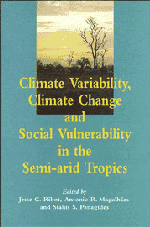Book contents
- Frontmatter
- Contents
- List of contributors
- Foreword by Tom Downing
- Preface
- List of abbreviations
- Introduction. Climate Variability, Climate Change and Vulnerability: Moving Forward by Looking Back
- PART I OVERVIEW
- PART II CLIMATE VARIATION, CLIMATE CHANGE AND SOCIETY
- 2 Climate Change and Variability in Mexico
- 3 The Impact of Climate Variation and Sustainable Development in the Sudano-Sahelian Region
- 4 Climate Change and Sustainable Development in China's Semi-arid Regions
- 5 Settlement Advance and Retreat: A Century of Experience on the Eyre Peninsula of South Australia
- PART III CLIMATE VARIABILITY AND VULNERABILITY: CAUSALITY AND RESPONSE
- PART IV THE INTERNATIONAL CONFERENCE ON THE IMPACTS OF CLIMATIC VARIATIONS AND SUSTAINABLE DEVELOPMENT IN SEMI-ARID REGIONS (ICID)
5 - Settlement Advance and Retreat: A Century of Experience on the Eyre Peninsula of South Australia
Published online by Cambridge University Press: 02 December 2009
- Frontmatter
- Contents
- List of contributors
- Foreword by Tom Downing
- Preface
- List of abbreviations
- Introduction. Climate Variability, Climate Change and Vulnerability: Moving Forward by Looking Back
- PART I OVERVIEW
- PART II CLIMATE VARIATION, CLIMATE CHANGE AND SOCIETY
- 2 Climate Change and Variability in Mexico
- 3 The Impact of Climate Variation and Sustainable Development in the Sudano-Sahelian Region
- 4 Climate Change and Sustainable Development in China's Semi-arid Regions
- 5 Settlement Advance and Retreat: A Century of Experience on the Eyre Peninsula of South Australia
- PART III CLIMATE VARIABILITY AND VULNERABILITY: CAUSALITY AND RESPONSE
- PART IV THE INTERNATIONAL CONFERENCE ON THE IMPACTS OF CLIMATIC VARIATIONS AND SUSTAINABLE DEVELOPMENT IN SEMI-ARID REGIONS (ICID)
Summary
INTRODUCTION
This chapter presents ongoing research into the Eyre Peninsula of South Australia, where there appears to have been at least a century of relatively well-documented intensification of land use paralleled by fluctuating socioeconomic fortunes and locally devastating impact upon the ecosystems of the area.
Among the current scenarios of future climate change for Australia are forecasts of the reduction of winter rainfall of up to 20% and increases in summer rainfall of similar proportions. Associated with these changes are increases in annual average temperatures of 1–3°C (Pittock and Hennessy 1991). Such forecasts have caused concern among rural planners in the cereal grain producing areas of southern Australia, especially where current economic constraints are reinforcing the marginality of much rural production and rural life-styles.
What follows is a preliminary account of research focusing upon the characteristics of the Eyre Peninsula (Fig. 1), the sources available for its study, and suggestions of some preliminary findings and general questions.
THE EYRE PENINSULA STUDY SITE
Sources
In terms of the last 100 years of human occupation, the Eyre Peninsula offers both abundant and spatially detailed data sources. The process of European occupation of the British Colony of South Australia, from 1836 onwards, was undertaken by a civilian government concerned with providing an orderly framework for the occupation and exploitation of the natural resources by the application of capital and labor. The intention here, as elsewhere in Australia, was the encouragement of private development within a broad framework of official land survey but private land ownership (Williams 1974).
- Type
- Chapter
- Information
- Climate Variability, Climate Change and Social Vulnerability in the Semi-arid Tropics , pp. 109 - 122Publisher: Cambridge University PressPrint publication year: 1996
- 1
- Cited by



